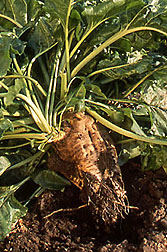This page has been archived and is being provided for reference purposes only. The page is no longer being updated, and therefore, links on the page may be invalid.
Study Finds Sugar Beet Varieties React Equally to Nitrogen Applications
By Stephanie YaoMay 13, 2009
A study conducted by Agricultural Research Service (ARS) scientists and their cooperators has dispelled a belief among some sugar beet growers that different sugar beet varieties require different nitrogen fertilization applications.
In integrated farming systems, sugar beet growers harvest the root for cash income and use the tops and root-processing byproducts for livestock feed. This dual benefit works well, but the amount of nitrogen fertilizer required to produce more tops decreases the amount of sugar in the root.
The contradicting objectives associated with this practice led some growers to wonder if those who specialize in sugar production and those with integrated farming systems need to employ different nitrogen fertilization practices, or if certain sugar beet varieties lend themselves better to one management system or the other.
In the study, ARS agronomist Bart Stevens, at the agency’s Northern Plains Agricultural Research Laboratory in Sidney, Mont., and cooperators from the University of Wyoming found there are very minor differences in how eight sugar beet varieties commonly grown in northern Wyoming and southern Montana respond to nitrogen fertilization. Therefore, growers do not have to further complicate their fertilizer-management decisions by adjusting nitrogen applications for individual varieties.
However, some varieties are designed to produce bigger tops at the expense of sugar content, so growers should continue to choose appropriate varieties based on their overall management objectives.
The study’s updated nitrogen-response information can improve recommendations for sugar beet, regardless of the grower’s production objectives or the variety being grown. Using the updated information tables found in the study’s manuscript, which is published in the Journal of Sugar Beet Research, growers can increase the efficiency of fertilizer applied in their operations, thereby improving net returns through increased sugar and/or tops production.
In addition, by reducing over-fertilization for top growth or the mistaken belief that certain varieties require additional fertilization, growers can cut their production costs even further and reduce potential environmental impacts due to leaching.
ARS is the principal intramural scientific research agency of the U.S. Department of Agriculture.

